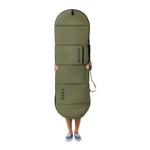Surfing is not only a fun and exhilarating sport, but it can also be a great way to stay active and enjoy the ocean. As a surfer, you'll need to transport your surfboard to your desired surfing spot, and strapping it to a roof rack is one of the most common and practical ways to do it. While it may seem intimidating at first, it's a skill that can be learned and mastered with a little practice and patience. By following the right steps and using the proper equipment, you can ensure that your surfboard is safely secured to your car's roof and ready for your next surf.
Steps To Strap a Surfboard to a Roof Rack
Step # 1 - Prepare the Roof Rack
- Clean the roof rack thoroughly before strapping your surfboard to it.
- It's important to remove any debris or old wax that may damage the surfboard during transportation.
- A few minutes spent cleaning the roof rack can save you from costly repairs or replacements.
- Use a soft cloth to wipe down the roof rack and remove any dirt or dust that may have accumulated on it.
- Check that the roof rack is securely attached to the vehicle before loading the surfboard.
- Ensure that the roof rack can support the weight of the surfboard to prevent any damage during transit.
- Add padding to the cross bars of the roof rack. This will protect your surfboard when you tighten it down.
Additionally, it's a good idea to inspect the surfboard for any existing damage before loading it onto the roof rack. If you notice any cracks or dings, it's best to have them repaired before hitting the waves.
Step # 2 - Place the Surfboard on the Roof Rack
Once you have successfully installed the roof rack on your vehicle, the next step is to securely place your surfboard on it. Before proceeding, make sure that the roof rack is properly fixed and stable to avoid any accidents or damage to your board or vehicle. When positioning your surfboard, it's important to ensure that it's centered and aligned with the vehicle to maintain aerodynamic efficiency and balance during transport.
If you have a surfboard bag that fits your surfboard, it can be an added advantage as it provides extra protection to your board during transportation. Also, remember to avoid overhanging the surfboard from the sides of the roof rack, as this can cause damage to your board and the vehicle. In addition to these precautions, it's also wise to regularly inspect your surfboard and surfboard cover for any signs of wear and tear. This includes checking for any dings, cracks, or scratches on your board, as well as ensuring the bag's zippers and straps are functioning properly. Regular maintenance not only prolongs the life of your surfboard and bag but also ensures you have a smooth and hassle-free experience every time you head out to surf.
Step # 3 - Secure the Surfboard with Straps
To transport a surfboard safely, you need to secure it properly with straps. Below are the steps to do it:
1. Choose the right straps
- Use high-quality straps designed specifically for surfboards.
- These straps are wider and thicker than regular straps, providing more support and stability to the surfboard during transportation.
2. Wrap the straps around the surfboard and the roof rack
- Wrap the straps around the surfboard and the roof rack, ensuring they're tight and secure.
- You can use two or three straps depending on the size of your surfboard.
3. Adjust the straps
- Make sure the straps are not too tight that they damage the surfboard or too loose that they don't provide enough support.
For those of you who prefer a visual guide on securing your surfboard to your vehicle, we've included a comprehensive video that walks you through the process step-by-step. This video is incredibly helpful, offering clear, easy-to-follow instructions that ensure your surfboard is safely attached to your roof racks, no matter the distance of your journey. Whether you're a seasoned surfer or new to the sport, this visual guide is a valuable resource to help you transport your board safely and efficiently.
Types Of Surfboard Straps
Choosing the right type of surfboard strap is essential for safely securing your board to your roof rack. Here are three common types:
Cam Straps: These are popular among surfers because they are easy to use and adjust. Cam straps have a simple buckle mechanism that allows you to tighten the strap by pulling on the free end. They are ideal for securely tightening the board without much effort. However, be careful not to over-tighten, as it could damage your surfboard.
Ratchet Straps: These straps offer a more secure hold compared to cam straps. They use a ratcheting mechanism that allows you to crank the strap tighter. While this provides a very firm grip, it can be harder to adjust and might take a bit more time to secure your board. Ratchet straps are great for longer trips where you need extra security.
Bungee Straps: These straps are made of stretchy bungee cords, offering flexibility. They are easy to attach and remove, making them convenient for quick trips. However, bungee straps may not provide as secure a hold as cam or ratchet straps, so they might not be the best choice for long distances or high speeds.
Pro Tip: Use Additional Padding
Use Additional Padding: When transporting your surfboard on your car's roof rack, it's crucial to take the necessary precautions to prevent any damage or scratches to your prized possession. Adding additional padding between the surfboard and the roof rack is an excellent way to ensure that it remains safe and secure during transportation.
Moreover, it's equally important to securely fasten your surfboard to the roof rack using high-quality straps. Opt for straps with a reliable locking mechanism and ensure they are tightly wrapped around both the board and the rack. This not only prevents the surfboard from shifting or potentially flying off the car while in motion but also reduces the risk of theft during stops.
Choose the Right Padding: Foam blocks, towels, or even an old yoga mat can be used to create extra cushioning. It's essential to make sure that the padding is evenly distributed and covers the entire length of the surfboard rack to prevent any potential damage.
Cover the Entire Length: Tie Down the Front and Rear of the Surfboard
- Place the surfboard on the roof rack and align it with the straps.
- Wrap the straps around the front and rear of the surfboard.
- Ensure that the straps are tight and secure, but not too tight, to avoid causing damage to the surfboard.
- Give the board a gentle shake to ensure that it is stable and not moving around.
Before You Go: Check the Straps
Before you hit the road with your surfboard canvas bag, it's important to double-check that all the straps are properly tightened and secure. One of the best ways to ensure that your surfboard is safe during transportation is to give it a gentle shake. This will help you to determine whether the board is stable and won't move around while you're driving. If you feel any movement, it's important to adjust the straps accordingly. It's also a good idea to periodically check the straps during your journey to make sure that they remain tight and secure at all times. By following these simple steps, you can ensure that your surfboard stays safe and secure while you're on the road.
Conclusion

In conclusion, strapping a surfboard to a roof rack is a simple process that can make transporting your board a breeze. By following the steps outlined in this guide, you can ensure that your board is safely secured to your vehicle, giving you peace of mind on the road. And if you're looking for high-quality 7' surfboard bags to protect your board during transport, be sure to check out FARO. Our bags are built to last, with a focus on quality, sustainability, transparency, exploration, and timeless design. So why wait? Visit FARO today and start exploring the world with confidence.





